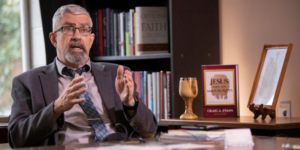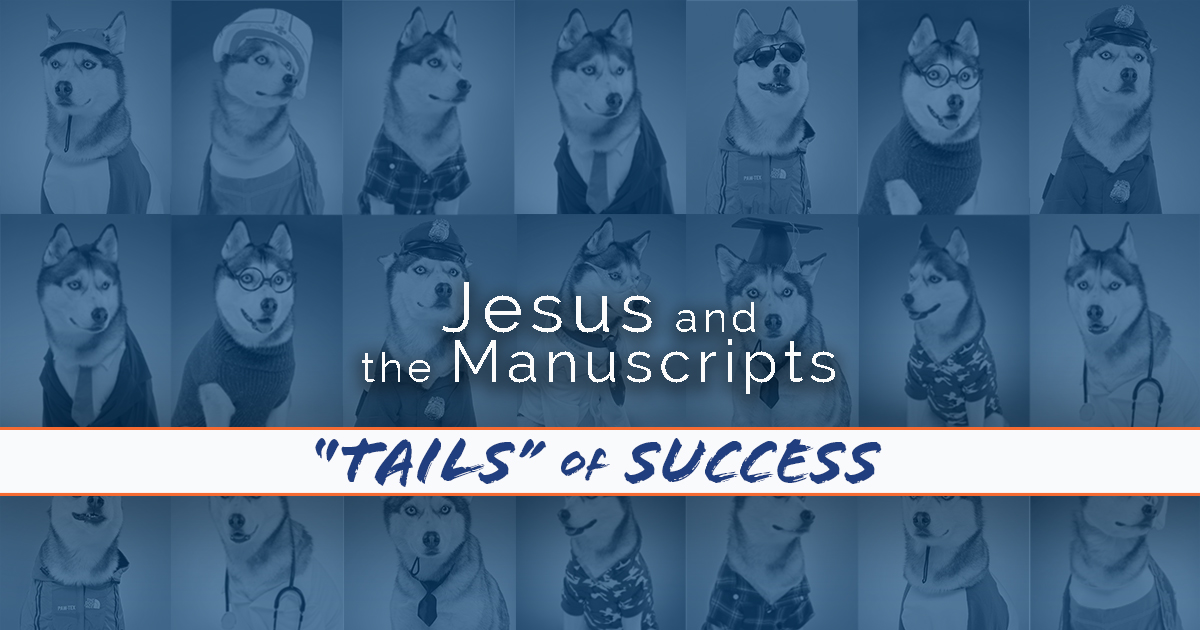
Dr. Craig Evans again combines faith and scholarship in his latest book, Jesus and the Manuscripts: What We Can Learn from the Oldest Texts. The John Bisagno Distinguished Professor of Christian Origins explains some of the takeaways from his research and examination of the ancient manuscripts and historical artifacts.
Tell us about your latest book and the manuscripts you studied.
“It’s about all the manuscripts in which Jesus appears. That would include the Qur’an, the Jewish Talmud, and extracanonical writings we have even from the first, second and third century. We went to several places to see the oldest codexes, including Dublin, Ireland; Manchester, Cambridge and Oxford, England; Geneva, Switzerland; and Rome, Italy. The book is designed for scholars, but I translate everything – every Greek, Latin, Hebrew phrase, Aramaic, and German writings – in the scholarly literature. Anybody can read my book. I have had some non-scholars read it and go, ‘Boy, that was deep,’ but they were able to get through it and understand it, so I feel good about that. It’s not just for scholars but for laypeople. It does have some beautiful photographs in the back and I’ve heard people express appreciation for that. They see manuscripts they’ve never seen before.”
How is Jesus portrayed in the texts?
“Even in the stories about Jesus as a child, I suggest that there’s a three-way conversation with Christians, Muslims, and Jewish rabbis and teachers. The complexity of the witnesses outside of the New Testament in several languages is compelling. Pagans were invoking the name of Jesus for protection, for health, and for healing. Two of these magic traditions – one on a ceramic cup and one on papyrus – both seem to date to about the middle of the first century. Which means Christianity as a movement was barely two decades old, and people already know that Jesus’ name is powerful. They don’t know much about him, they can’t tell the story correctly, maybe they don’t know anything about what the Christians actually say, but within just a few years, Jesus is known well outside the Church and outside of the land of Israel as a powerful healer and a protector against evil spirits. I find that fascinating. So I talk about that in the book as well.”
How common is it to find Jesus referenced?
“You quickly learn just how well-documented Jesus is. You expect an emperor to be well-known. Jesus is right up there with Augustus and Julius Caesar for being extremely well-known and for people writing biographies. It’s a rare figure in antiquity that gets as much press coverage as Jesus, which flies in the face of the silly mythicists who say things like, ‘If Jesus was really who the Gospels say he was, why don’t we hear more about him?’ You hear as much about him as any emperor. How much more do you want? And Christianity as a movement doesn’t sweep the Roman Empire until the fourth century, and did so with no violence and no armies marching around conquering cities and killing people. The Gospel spread and overcame all kinds of obstacles, persecution, resistance, and so on. What I’m trying to do in my book is make that clear and well-documented so even a scholar who is an expert in one or two of these areas really can’t push back. I do my homework and I cover all the ground.”
How does the scholarship affect the study of canonical (biblical) texts?
“One chapter talks about how the printing press impacted the way we understand Scripture. The idea that it should be the King James version and nothing else or it’s this particular version of the Greek text – this never would have happened had it not been for the printing press. Everybody knew that handwritten manuscripts varied a little bit and you would compare them – two or three different ones and say, ‘Oh yeah that’s the original reading or this is slightly off.’ Everybody knew that back when all manuscripts were handwritten. And that’s what the word manuscript means: manu – hand, and script – writing. I suggest that because Jesus appealed to Scripture, not just according to the Hebrew, but appealed to Scripture in the Aramaic, I think it opened the door for his apostles to appeal to the Old Testament and in Greek. That created a paradigm where the canon of Scripture could be Hebrew, it could be Greek, it could be Latin; that’s okay. And I think that’s something important that we all need to understand. It isn’t just this one version of a book of the Bible. It’s okay to have two or three versions, which is the way it is in the Church. And the Church is not messed up. It actually reflects a pragmatic and experiential approach to Scripture that you see in Jesus Himself and His teaching. But if the laity, the people in the pews in the church and the pastors – if they know their stuff, then they stand on very firm ground and they can offer a solid defense for the truthfulness and the reliability of the Gospels.”
School of Christian Thought Recent Notable Works
David Baggett
The Moral Argument: A History (Oxford University Press), 2019
Ben Blackwell
Ben C. Blackwell, John K. Goodrich and Jason Maston, eds. Reading Revelation in Context: John’s Apocalypse and Second Temple Judaism. Grand Rapids: Zondervan, 2019
Ben C. Blackwell, Randy Hatchett, Engaging Theology: A Biblical, Historical, and Practical Introduction, Zondervan Academic, 2019
Tim Brookins
Brookins, Timothy. Reading 1 Corinthians. Reading the New Testament. Smyth & Helwys, 2020
Craig Evans
考古耶穌:解開上帝兒子身分的迷思 (ed. and trans. by Li Chun; Hong Kong: InPress Books, 2019) xv + 131 pp. = Who is Jesus? Archaeology, Text and Context (only published in Chinese).
Editor, with David Mishkin, Handbook of the Jewish Roots of Christianity (Peabody MA: Hendrickson, 2019) xx + 354 pp. + 28 figures.
Author, Jesus and the Manuscripts (Peabody MA: Hendrickson, 2020) xxxiii + 650 pp.
Author, with John J. Collins and Lee M. McDonald, Ancient Jewish and Christian Scriptures: Old Questions and New Developments (Louisville: Westminster John Knox, 2020) xvii + 252 pp.
Author, with Bart D. Ehrman and Robert B. Stewart, Can We Trust the Bible on the Historical Jesus? (Louisville: Westminster John Knox, 2020) xii + 100 pp.
Editor, with Jeremiah J. Johnston, Scribes and Their Remains (LSTS 94; SSEJC 21; London and New York: Bloomsbury T&T Clark, 2020) xv + 320 pp.
Editor, with Aaron White, Who Created Christianity? Fresh Approaches to the Relationship Between Paul and Jesus (Peabody MA: Hendrickson, 2020) xv + 472 pp.
Editor, with B. J. Oropeza and Paul T. Sloan, New Studies in Intertextual Interplay (LNTS 632; SSEJC 20; London and New York: Bloomsbury T&T Clark, 2020) xii + 267 pp.
Editor, with B. D. Chilton, A. Avery-Peck, D. L. Bock, D. M. Gurtner, J. Neusner, L. H. Schiffman, and D. Oden (eds.), A Comparative Handbook to the Gospels of Matthew and Luke: Comparison with Pseudepigrapha, the Qumran Scrolls, and Rabbinic Literature (The New Testament Gospels in their Judaic Contexts 2; Leiden: Brill, 2021).
Randy Hatchett
Ben C. Blackwell, Randy Hatchett, Engaging Theology: A Biblical, Historical, and Practical Introduction, Zondervan Academic, 2019
Chris Kugler
Chris Kugler, Paul and the Image of God (Lanham, MD: Lexington Books/Fortress Academic, 2020).
Chris Kugler, The Next Christian Faith: A Brief Sketch (Eugene, OR: Cascade, 2021).
Jason Maston
Ben C. Blackwell, John K. Goodrich and Jason Maston, eds. Reading Revelation in Context: John’s Apocalypse and Second Temple Judaism. Grand Rapids: Zondervan, 2019
Mike Licona
David Beck and Michael R. Licona, eds. Raised on the Third Day: Defending the Historicity of the Resurrection of Jesus; Essays in Honor of Gary R. Habermas (Bellingham, WA: Lexham Press, 2020).
Philip Tallon
The Absolute Basics of the Wesleyan Way, Seedbed, 2020
Michael Ward
Contributed essays in:
The Story of the Cosmos: How the Heavens Declare the Glory of God, ed. Daniel Ray and Paul Gould (Harvest House, 2019)
The Inklings and Culture, ed. Laura N. Van Dyke, Monika Hilder, and Sara L. Pearson (Cambridge Scholars Publishing, 2020)








